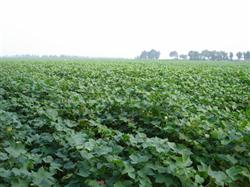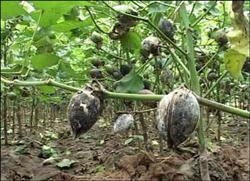Why is the cotton rotten? How to prevent cotton boll rot?

Why does cotton rot? How to control cotton bolls? Please give an introduction Cotton bolls rot, which happens almost every year to varying degrees. Therefore, comprehensive measures should be taken to control cotton boll rot on the basis of clarifying the conditions and causes of boll rot, and strive to reduce the loss to a minimum. 1. Conditions and causes of cotton boll rot Cotton boll rot is caused by infection of cotton bolls by various pathogens. Especially in cloudy and rainy weather, cotton field humidity is relatively high, canopy is serious, ventilation and light transmission are poor, suitable for pathogen reproduction and infection, diseases are often serious, cotton boll rot is also more serious. Cotton boll diseases mainly include blight, anthracnose, angular spot and red rot, among which blight is the main damage type of boll rot, accounting for 28.3%~99.7% of boll diseases. Extensive cotton field management, untimely pruning or chemical control measures, vigorous plant growth, etc., are conducive to disease. 2. Control measures of cotton boll rot 1. Rational fertilization. Increase organic fertilizer and phosphorus and potassium fertilizer, appropriate use of nitrogen fertilizer, prevent cotton plants from flourishing, reduce cotton field depression, improve ventilation and light transmission conditions. 2. Timely drainage. For low-lying, poor drainage, ponding heavier cotton field, should deepen the drainage ditch, in order to speed up the drainage speed. Eliminate the waterlogging and dark water in cotton field, improve the growth and development conditions of cotton, realize more peach bearing, no premature senescence and reduce the damage of boll disease. In addition, for cotton field drainage and prevention of cotton lodging, cultivating soil before cotton flowering is also an effective agronomic measure, which should be advocated. 3. Adjust the knot bell. Cotton covered with plastic film or early-sprouting cotton has too many pre-harvest peaches. Boll rot can be reduced by taking effective measures to adjust boll setting period and boll setting position. 4. Reasonable pruning. For cotton fields with too narrow row spacing and too early sealing, in order to reduce excessive cover in the field and improve the light conditions and ventilation conditions in the middle and lower parts, the edge center should be knocked as soon as possible, which can reduce the loss of bolls and rotten bolls. 5. Picking up sick bells. The boll period more than 40 days, boll shell has faded yellow began to appear black cotton, before the rotten harvest. The cotton bolls could be obtained by dipping the harvested cotton bolls in 1% ethylene solution and drying them. 6. Chemical control. Chemical control is an important measure for comprehensive control of cotton boll rot, and targeted fungicide spraying should be carried out. From August to September, when the weather forecast has rainy weather for several consecutive days, spraying protection should be carried out in time. Spraying should be concentrated in the middle and lower parts of cotton plants. Commonly used medicaments include 50% carbendazim 1000 times solution, 58% metalaxyl manganese zinc wettable powder diluted 600~800 times solution, 70% chlorothalonil wettable powder diluted 500 times solution, etc. Click for more cotton growing technology Click for more food crop growing technology
- Prev

What diseases do you need to control when planting cotton?
What diseases do you need to control when planting cotton? Please introduce that the diseases of cotton are different at different stages of growth. The diseases and control of cotton at seedling stage are introduced below for reference. Seedling disease-blight (dead seedlings). After the cotton seedling is unearthed, the yellow-brown disease spot appears at the base of the stem (where it meets the land).
- Next

How to prevent cotton boll rot with high temperature and humidity?
How to prevent cotton boll rot with high temperature and humidity? Please introduce the methods of cotton boll rot prevention and control with reference to the following methods: 1. Rational fertilization: increase the application of organic fertilizer and phosphorus and potassium fertilizer, and apply appropriate amount of nitrogen fertilizer to prevent cotton plant growth, reduce cotton field closure, and improve ventilation and light transmission. 2. Timely drainage: for low-lying terrain.
Related
- The first cup of black tea in spring, the flavor and history of tea gardens in Kenya, Africa
- The computer can not only choose potatoes, but also grow tea rice. AI will grow winter oolong tea champion.
- It is not only the inflated tea bitten by insects, but also engraved with the four seasons tea in Beipu.
- The Oriental Beauty Tea Festival in Zhuxian County takes the stage at the weekend to experience the plus-size feast of oil tea.
- & quot; Oriental Beauty Tea & Exploration of Emei in Hsinchu, the hometown of quot;
- The new variety of strawberry "Tainong 1" dessert is the first choice with mellow aroma. Crimson gorgeous
- History of Tea in Taiwan: from Wild Inner Mountain to Export Tea Garden
- Two types of Taiwan Oriental Beauty Black Tea won the British three-Star Award for Childhood Tea Xiang Zhang Jiaqi changed from pilot to champion tea maker.
- Banana species and varieties: the planting history of Taiwan Xianren banana and dwarf banana is long, is banana disease resistant?
- Coffee planting Technology: Qianjie Coffee from Seedling to harvesting

